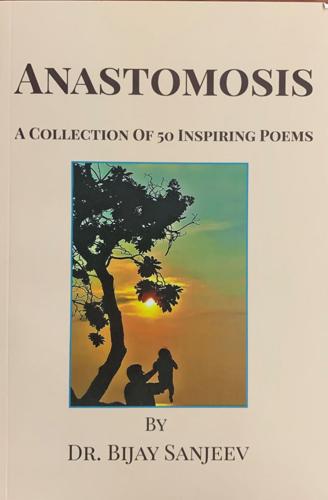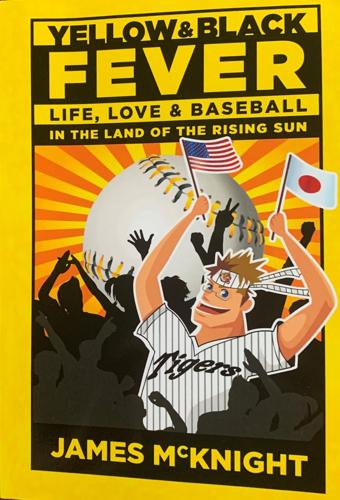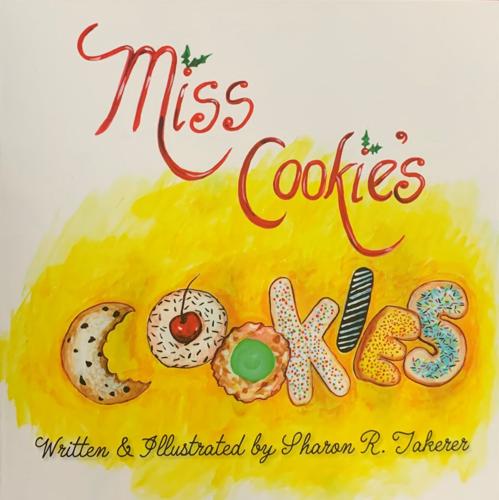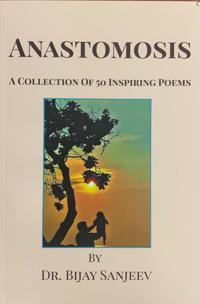“Anastomosis: A Collection of 50 Inspiring Poems”
By Dr. Bijay Sanjeev (Self-published). Available at blurb.com/bookstore. Hardcover $30.71; paperback $19.71; PDF $9.99; e-book $12.99.
Tucson internist Bijay Sanjeev was a child in a modest town in India when watching his grandmother’s physician inspired him to become a doctor: “The greatest thing a human being can do,” he decided, “is to cure.” Over his career, he found that his role was not simply as “diagnoser of ailments and prescriber of medications,” but as a healer — “educator, counselor, and preventer of disease and promoter of health.” This slim collection testifies to this aspiration. Aptly titled “Anastomosis” (“the union of parts or branches so as to inter-communicate or interconnect”), the poems reflect on both physical and spiritual life. They cover life passages: from “Child’s Dream”: “My innocent face, longing eyes and gentle mind/ Want to live with people who are gentle and kind.” They give life advice: “Happiness is a journey/ Not the destination” and “When you still have time/ Think of love not hatred or crime.” They promote racial tolerance, healthy living, and faith; and each poem is accompanied an inspirational photograph. The book — dedicated to Sanjeev’s family — is imbued with the affection from which its inspiration clearly drew.
— Christine Wald-Hopkins
“A Line in the Sand”
By Vern Lamplot (Self-published). Paperback $11.40; e-book $2.99.
This series debut by a “recovering journalist,” retired university public information administrator and director of the Mission San Xavier restoration is set in territory familiar to any Tucsonan. It features Puerto Peñasco (Rocky Point), the University of Arizona (here called the University of Southern Arizona), Tucson, and the Sonoran Desert between. Opening with U.S. students on a biology field trip partying in a Puerto Peñasco club, it quickly moves to a couple of tipsy American expats finding a dead girl on the beach — university freshman Naima Singh. The Puerto Peñasco officer leading the investigation of the death is young Sgt. Antonia Ramirez, and she’s immediately under pressure: The parents want to return the girl’s body to Tucson. The Puerto Peñasco mayor wants to protect his town’s reputation, as does the university its own. So the death is quickly ruled an accident, and Naima’s body and the U.S. students — including her three possible witness roommates — are whisked off to the United States, beyond Mexican jurisdiction. Sgt. Ramirez, however, can’t let it go. She suspects homicide and recruits one of the expats, retired Phoenix detective “The Sandman” Sanderson, to join her to continue an investigation. What follows is a fast-moving, bloody cross-border thriller that involves competing cartels, a small-time drug-dealing Mexican kid, a Tucson reporter and an unlikely gun-toting waila band called Sand Papagos. It’s a laudable debut, and we can look forward to further Sonoran Borderlands Mysteries.
— Christine Wald-Hopkins
“Yellow and Black Fever: Life, Love & Baseball in the Land of the Rising Sun”
By James McKnight (Yellow and Black Tigers Press). $15.99 paperback; e-book $5.55.
In the year 2000, journalism grad James McKnight was 32, girlfriend-less, toiling in a dead-end government job in Phoenix, and spending his time drinking beer and watching sports when his best friend and fellow drifter Miguel died suddenly. That brought McKnight up short: He realized he didn’t want to die — like Miguel — without finding purpose in life. Having been charmed by Japan the previous year, he decided to go back. He landed himself an English teaching job and moved. This memoir covers four years of the 12 he’d spend in Japan.
A lifelong Cleveland Indians fan (a Tucsonan, he discovered baseball as a kid following Indians spring training at Hi Corbett), McKnight stumbled into — and fell in love with — a bottom-of-the-league Japanese team, the Hanshin Tigers. We follow McKnight learning Japanese culture from his middle school teaching experience and from the exuberant Tigers fan culture. Not to give away too much — yes, young James does have some girlfriend success — but his real passion is revealed by the inning-by-inning replays of the games he attended. Those Japanese fanatics way outdo Americans — they form tight clubs, they sing songs for individual players, they join arms and dance in circles; and they’re champs at knocking them back. It goes without saying that McKnight found purpose in Japan. And you’ve gotta admire folks who can party until 3 a.m. and show up to teach at 8.
— Christine Wald-Hopkins
“The Commissioners of Indian Affairs: The United States Indian Service and the Making of Federal Indian Policy, 1824-2017”
By David H. Dejong. The University of Utah Press. Hardcover $75; paperback $40.
In his thought-provoking preface to “The Commissioners of Indian Affairs,” author David H. Dejong observes that the United States was the first nation in history to be founded on the belief that personal property equaled personal liberty, and land not in private hands benefited no one. The Founding Fathers essentially made the acquisition of land a God-given right but failed to provide a clear-cut solution to the problematic presence of Indigenous people already occupying the land communally. The moral solution — or, that is to say, what appeared to pass as morality — involved a two-pronged approach of removing Indigenous people from their land and assimilating them into the dominant social fabric, extinguishing tribal culture and instilling European values in its place. Myriad federal policies were introduced to reach these goals, and the task of implementing these policies became the purview of the commissioner of Indian affairs.
It’s a powerful position. Commissioners have an outsized impact on native people, and not always for the good, as Dejong illustrates in this deeply researched and thoughtful book. His investigation involved reading each of the annual reports produced by the commissioners, beginning in 1824, so as to identify and track the policies that reflected philosophies that evolved over time as political winds shifted and the nation’s moral compass spun. This is by no means a casual read, but it is a revealing, meticulously documented survey that will be welcomed by those with an interest in American history, and essential reading for scholars of federal Indian policy. David Dejong is director of the Pima-Maricopa Irrigation Project and the author of “Forced to Abandon Our Fields: The 1914 Clay Southworth Gila River Interviews,” and “American Indian Treaties: A Guide to American Indian Treaties and Treaty-Making, 1607-1911.”
— Helene Woodhams
“Miss Cookie’s Cookies” & “Shoezee”
By Sharon Takerer. Wheatmark. $10.95 each.
If Miss Cookie’s team of sled dogs had not collided with Mikey the Elf and his fleet of reindeer that fateful Christmas Eve, Santa Claus might still be snacking on soda crackers. Instead, the happy mishap introduced him to Miss Cookie’s vastly superior concoction of “flour, sugar, cinnamon and vanilla.” For Santa, it was nothing short of a revelation: Miss Cookie was offered a job on the spot as “Sweet Treats Supervisor.” She got to work baking cookies by the boatload, and Santa’s taste buds were never bored again. With this new picture book, Tucson author Sharon Takerer, author of story-time read-aloud favorites including “Oh Ednacita!” and “Seamus, the Patron Snake of Ireland,” turns her attention to the happiest time of year, demonstrating to the youngest readers why it’s also the sweetest.
Takerer provides her own colorful illustrations to complement her lively stories and has made good use of at-home time during the pandemic by turning out not one, but two new picture books.
Joining “Miss Cookie” is “Shoezee,” a little girl whose enviable collection of footwear — from fuzzy slippers and flip-flops to cowboy boots and ballet slippers — is celebrated in rhyme. Touchingly, “Shoezee” is dedicated to the late Justice Ruth Bader Ginsberg, whose wisdom and fashion savvy are much admired by the author.
— Helene Woodhams
“Yoga for Holistic Healing: Poses & Sequences for Pain and Stress Relief”
By Bonnie Golden. Rockridge Press. $16.99; $6.99 Kindle.
The practice of yoga can sound intimidating to the uninitiated, and that’s unfortunate. The benefits of yoga for improving health, diminishing pain and alleviating mental suffering have been well-documented by medical research. Author and certified yoga instructor Bonnie Golden has made it her mission to demystify the ancient practice and demonstrate how it can be accessible to everyone, regardless of age, flexibility and concentration span. With this upbeat, easy-to-understand book she does just that.
At the heart of her teaching is the “powerful integration of the mind/body/breath.” Achieving this integration is empowering, says Golden, because yoga is more effective than the sum of its parts. With anatomical drawings provided for reference, the book is divided into upper-body and lower-body poses and sequences that are well-illustrated and minutely described, with body and mind areas targeted for relief of pain or discomfort. Alternatives are offered for poses that seem too challenging. It’s an effective presentation, but what really sets this book apart is Golden’s friendly, enthusiastic and knowledgeable delivery. Her motto, “It’s YOUR yoga,” feels at once sincere and achievable. Golden, who lives in Tucson, specializes in yoga for healthy aging as well as in pregnancy and postpartum corrective exercise, and teaches yoga across the lifespan in classes, workshops and private sessions.
— Helene Woodhams

















